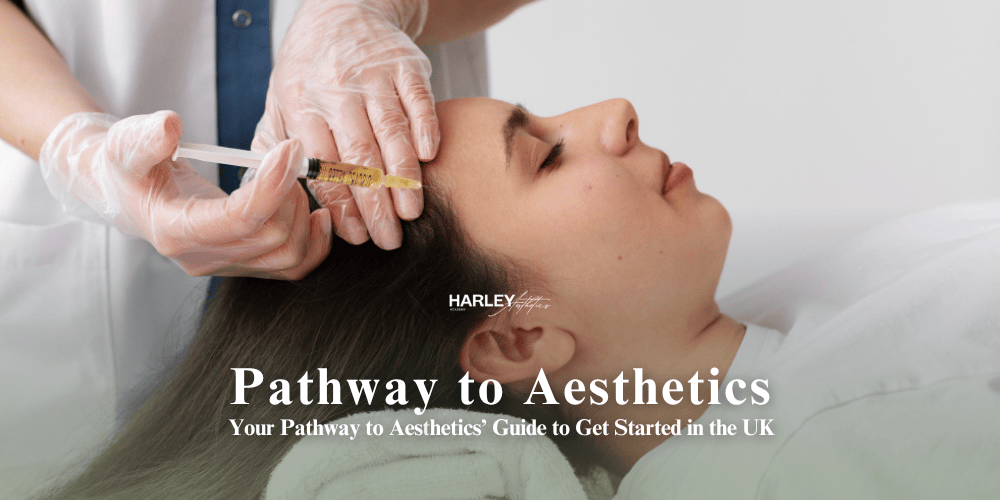July 2025 Sale – 40% Off Get Offers

If you’re here, you’re probably feeling curious, hopeful – even a bit overwhelmed. You’ve likely seen the growing popularity of aesthetic treatments all over social media and the web. But behind every stunning before-and-after photo is a trained practitioner who once stood exactly where you are now, wondering how to get started. This is your pathway to aesthetics, and it’s a journey worth taking.
The term Pathway to Aesthetics isn’t just clever branding, it’s a meaningful step-by-step transition from curiosity to career. Whether you’re a medical professional looking for a change, a beauty therapist hoping to offer injectables, or someone with zero clinical background who simply wants to learn, there’s a structured route into aesthetics with good aesthetic courses. One such example is a Pathway to Aesthetics course combining foundation training in both dermal fillers and anti-wrinkle injectables, designed specifically to support learners just like you.
In this detailed guide, we’ll walk through the entire journey. From understanding the basics, to what courses entail, to what your career might look like a year from now, we’ll explore it all.
So, grab a cuppa and let’s get into it.
Let’s break it down.
“Pathway to Aesthetics” refers to the structured journey a learner takes to become a trained and competent aesthetic practitioner. This pathway usually includes foundational training, practical skills development, clinical oversight, and eventually, business setup all included in a well designed course among many of the available aesthetic courses..
But your pathway to aesthetics is more than just education. It’s also about:
Unlike short online certificates or crash courses, a true pathway should leave you feeling supported, technically, emotionally, and professionally.
You might be asking: Is this career change really possible for someone like me?
Short answer: Yes.
Here’s a look at the wide range of people now exploring aesthetic courses as a legitimate next step:
Many NHS nurses are turning to aesthetics for more autonomy, flexibility, and income potential. If you’re already used to injections and patient care, aesthetics is a natural next step.
Those already trained in skincare and facial treatments often pursue aesthetics to expand their service offerings. Their client rapport and skincare knowledge give them a strong head start.
From accountants to fitness instructors, many professionals are seeking more meaningful work. With proper training, even complete beginners can enter this industry with confidence and competence.
Not everyone who starts this journey wants to run a clinic. Some people take courses to understand treatments they already get themselves, or simply out of curiosity about how the field works.
Wherever you fit, there’s room on this pathway for you.
Many newcomers think they can just take a one-day class and start injecting. But let’s be honest, this industry demands more than that.
Here’s what a structured, ethical pathway to aesthetics typically involves:
Theoretical Training
Understanding facial anatomy, ageing processes, product types (like hyaluronic acid-based fillers), and the pharmacology of anti-wrinkle treatments.
Practical Training
Live model work is essential. You’ll learn correct needle placement, dosage, safety techniques, and how to handle complications.
Consultation Skills
You’re not just injecting – you’re advising clients, managing expectations, and making decisions based on safety and suitability.
Post-Course Support
The best training doesn’t end when you walk out the door. You’ll want access to mentoring, refresher training, and help with things like insurance and clinical setup.
Your pathway to aesthetics isn’t just about earning, it’s about doing right by your clients. In a field where the results are visible and emotional, integrity is everything.
You’ll need to:
Courses that teach ethical practice are worth their weight in gold. They not only improve your technical skill, they make you a practitioner clients trust and recommend.

Once you’ve completed your foundation course, what’s next?
Take photos (with consent), gather testimonials, and document your treatments. This builds trust and shows future clients what you’re capable of.
You’ll need insurance, consent forms, aftercare guidance, and possibly a prescribing partner (if you’re not prescriber-qualified).
Instagram is huge in aesthetics. So is word of mouth. Start by offering treatments to family and friends, then grow organically.
Once you’re comfortable, progress to advanced techniques such as cheek sculpting, lip enhancement, skin boosters, and more.
Your pathway to aesthetics doesn’t end with one course, it evolves as you grow into a more confident, capable, and in-demand professional.
People diving into aesthetics often have the same concerns. Let’s unpack them.
Not necessarily. Some providers offer courses for non-medics, especially those with beauty qualifications. However, regulations may vary by region and treatment type; so always check local requirements.
Basic training can be completed in a few days or weekends, but experience builds over months. Many students begin treating clients within 1-3 months, with ongoing mentorship.
Yes. Many trained practitioners go on to start home-based or mobile clinics. Others partner with salons, join aesthetics clinics, or build freelance portfolios.
Depending on location and service pricing, aesthetic practitioners can earn £150–£350 per treatment. A well-run part-time clinic can comfortably bring in £2,000-£4,000 a month.
That’s where proper training comes in. A good course teaches you not just how to perform treatments, but how to handle emergencies calmly and ethically.

Choosing a career in aesthetics isn’t just a professional decision, it’s a personal one. It means stepping into a field that values precision, beauty, trust, and confidence.
With the right training, support, and mindset, you can start from zero and become a trusted practitioner helping people look and feel their best. The journey will have challenges but it will also be full of growth, independence, and genuine fulfilment.
But choosing the right course for you among all the available aesthetic courses. out there can be stressful. If you’re ready to take the first real step, a properly structured Pathway to Aesthetics course might be exactly what you’re looking for. With expert-led tuition, hands-on practice, and post-course support, it’s more than just a class, it’s your launchpad into a whole new future.
Because your journey isn’t just about learning to inject, it’s about becoming someone others trust with their confidence. That’s a responsibility worth preparing for.
© Harley Aesthetics Copyright 2025. All Rights Reserved.